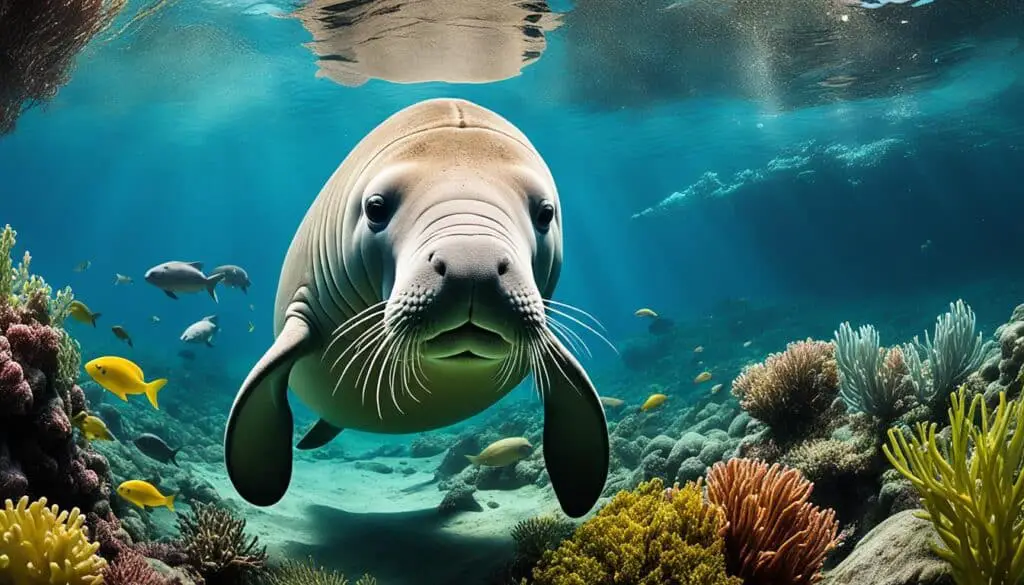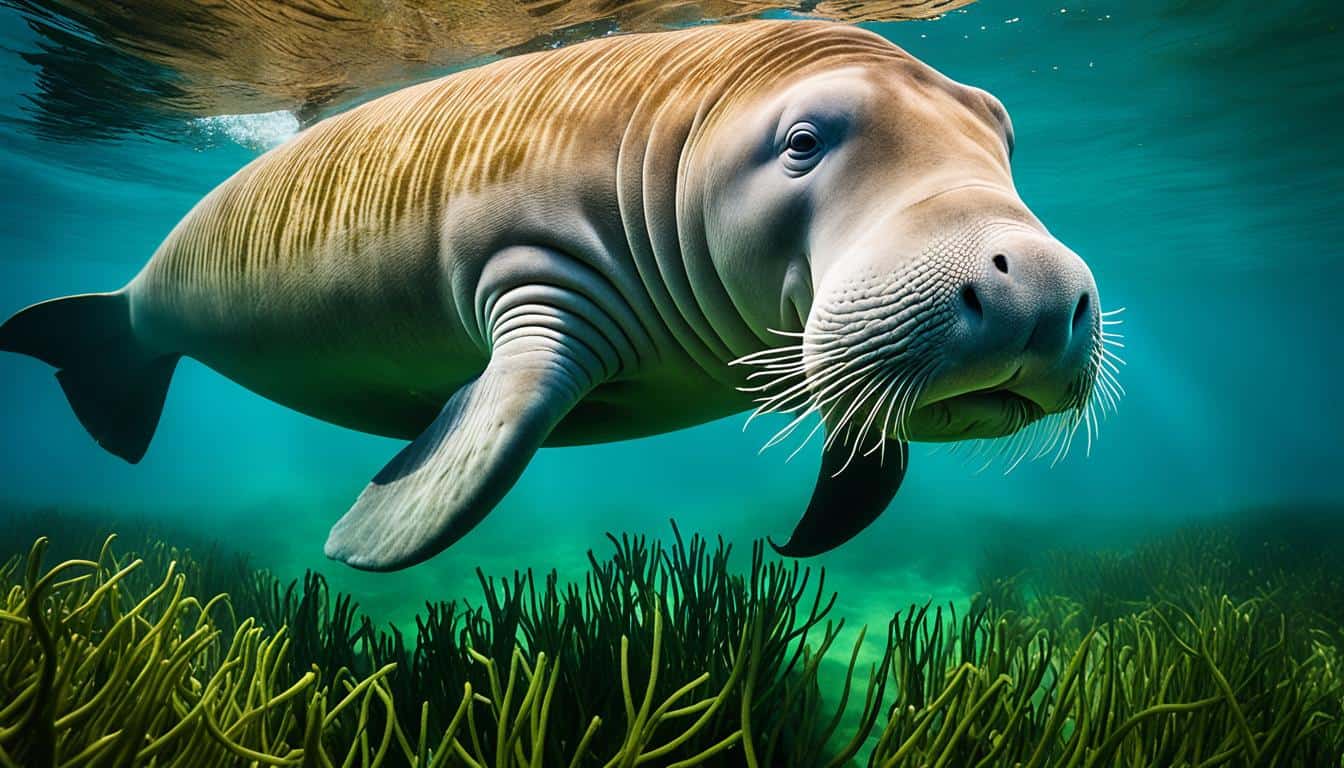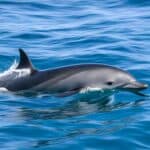Dugongs are fascinating marine mammals with amazing navigation skills. You might ask, how do they find their way in the vast oceans? These gentle creatures live in shallow coastal areas with lots of seagrass. This helps them survive.
They use many techniques and biological adaptations to move around. These animals live in 48 countries, from East Africa to Vanuatu. Big groups are found in Australia and the Arabian Gulf.
We will look into how dugongs navigate their habitats. We’ll see the strategies they use to survive in the complex ocean.
Dugong Navigation Techniques
Dugongs use amazing navigation techniques to survive in the ocean. These methods help us understand how to protect their home and food. This is key for marine conservation.
Using Environmental Cues
Dugongs depend a lot on their surroundings to find their way. Seagrass beds are important for food and as landmarks. They use these to decide where to eat and live.
Utilizing Acoustic Signals
Dugongs can hear changes in the water with their sensitive ears. They make sounds to talk to each other and find their way underwater. These underwater navigation techniques are crucial for their social life and finding food.
Importance of Seagrass Beds
Seagrass beds affect dugong behavior and movement a lot. They give them food and help them navigate. Keeping seagrass areas healthy is key for marine conservation and dugong survival.
How do dugongs navigate?
Dugongs use their amazing spatial memory and know their surroundings well. This helps them find food across their home.
Spatial Memory and Learning
Dugongs can remember where seagrass grows, which is key for finding food. They make mental maps as they explore. This lets them move easily to places with lots of seagrass.
Influence of Ocean Currents
Ocean currents help dugongs move around. They swim with these currents to save energy. This way, they can travel far and find food without getting tired.

| Navigation Method | Description | Impact on Foraging |
|---|---|---|
| Spatial Memory | Ability to remember locations of seagrass | Enhances efficiency in locating food |
| Ocean Currents | Utilization of currents for movement | Conserves energy during long travels |
Dugong Behavior and Navigation
Dugongs show complex behaviors that greatly impact their way of moving around. These behaviors shape how they feed and live together. They help them navigate, feed, and build social groups.
Social Structures and Herds
Dugongs often live in groups, which are key for their survival. These groups help with finding food and moving around. Older dugongs teach younger ones important paths to follow.
During mating, males compete to win over females. This shows how important social life is for dugongs.
Feeding Patterns and Migration
What they eat affects how they move through the ocean. Dugongs mainly eat seagrass, which grows in certain spots. They move to places with lots of seagrass to get enough food.
This shows how their eating habits and navigation are linked. It’s a key part of their life in the ocean.
| Behavior Type | Details |
|---|---|
| Social Structures | Dugongs form herds that assist in navigation and feeding. |
| Mating Behavior | Males display competitive behavior to attract females. |
| Feeding Patterns | Dugongs migrate to areas rich in seagrass for nutrition. |
| Learning Navigation | Younger dugongs learn routes from more experienced individuals. |
Marine Biology Perspective on Dugong Navigation
Studying how dugongs navigate the sea gives us a peek into marine biology. These marine mammals have special traits that help them move through the water. These traits are key to their survival and how they find their way around.
Physiological Adaptations
Dugongs have unique features that make them great at navigating. They don’t have a dorsal fin, which helps them move smoothly through the water. Their flippers are shaped like paddles, making it easy for them to swim and turn in seagrass habitats.
They also have a sharp sense of hearing. This helps them since they can’t see very well. By listening, they can find food and know where they are in the water.
Behavioral Studies and Observations
Studies show that dugongs use what they’ve learned to navigate. They have smart ways to find their way around. They use things like water temperature and tides to help them find food or move to new places.
Seagrass beds are very important to them. They eat there and use it to help them navigate. Living in groups also helps them navigate better. They share tips on the best paths to take.
| Physiological Adaptations | Behavioral Observations |
|---|---|
| Lack of dorsal fin | Use of environmental cues for navigation |
| Paddle-like flippers | Social structures enhance learning |
| Acute sense of hearing | Adapting migratory routes over time |
Conservation and Dugong Navigation
The need to save dugongs is urgent as they face many threats, making them endangered. Efforts to protect these gentle sea creatures focus on keeping their homes safe. These homes are vital for their survival, including where they live, eat, and have babies. Saving their homes helps not just them, but also the balance of the ocean’s life.
It’s important to know how dugongs move through the ocean to help protect them. Things like coastal development and harming their homes change their lives. Keeping the seagrass beds healthy helps dugongs move and live better.
To help dugongs, we need to take big steps in ocean conservation. Learning about why their homes matter helps us all. By teaching others, we can keep working to save this endangered species and help the ocean’s future.
FAQ
How do dugongs navigate their environment?
Dugongs mainly use seagrass beds to find food and navigate. They also rely on their sharp hearing to sense changes around them.
What role do seagrass beds play in dugong navigation?
Seagrass beds are key for dugongs. They offer food and help them find their way. The presence of seagrass affects their movement and eating habits.
How do dugongs communicate to aid in navigation?
Dugongs make sounds to talk to each other. This helps them stay oriented and move around. Their keen hearing lets them hear these sounds well.
What is the significance of spatial memory in dugong navigation?
Dugongs have great spatial memory. They remember where seagrass is. This skill is vital for finding food and moving around.
How do ocean currents influence dugong navigation?
Dugongs use ocean currents to travel long distances. This helps them find food while saving energy.
What social structures do dugongs have that assist in navigation?
Dugongs live in groups, which helps with finding food and moving around. Young ones learn from older ones, and mating rituals show their social nature.
Why are dugongs classified as vulnerable to extinction?
Dugongs are threatened by habitat loss, mainly from human activities like coastal development and harming seagrass. These threats affect their ability to navigate, find food, and breed, making them vulnerable.
What physiological adaptations do dugongs have for navigation?
Dugongs don’t have a dorsal fin but have paddle-like flippers for moving well in water. Their sharp hearing helps make up for their limited sight, aiding in finding their way.
How do conservation efforts support dugong navigation?
Conservation efforts protect seagrass ecosystems, crucial for dugongs. Healthy habitats help keep the species safe from extinction.







